| Pages:
1
..
3
4
5 |
Bert
Super Administrator
        
Posts: 2821
Registered: 12-3-2004
Member Is Offline
Mood: " I think we are all going to die. I think that love is an illusion. We are flawed, my darling".
|
|
Yes. See Shimizu FAST for details, or various other published techniques for using ammonium perchlorate with Magnesium or 50:50 Magnalium alloy- AP
and various sulfate based colored strobes, in particular.
Rapopart’s Rules for critical commentary:
1. Attempt to re-express your target’s position so clearly, vividly and fairly that your target says: “Thanks, I wish I’d thought of putting it
that way.”
2. List any points of agreement (especially if they are not matters of general or widespread agreement).
3. Mention anything you have learned from your target.
4. Only then are you permitted to say so much as a word of rebuttal or criticism.
Anatol Rapoport was a Russian-born American mathematical psychologist (1911-2007).
|
|
|
MineMan
National Hazard
   
Posts: 998
Registered: 29-3-2015
Member Is Offline
Mood: No Mood
|
|
Bert. I have tried that mixture but it did not burn as fast in the open as flash so I ditched it. But potassium perchlorate and my burns extremely
fast unconfined, but confined will not burst a copper tube, only open the ends.
I have found the reverse to be true, so I need to give it a try. AP produces a lot of gas too...
|
|
|
PHILOU Zrealone
International Hazard
    
Posts: 2893
Registered: 20-5-2002
Location: Brussel
Member Is Offline
Mood: Bis-diazo-dinitro-hydroquinonic
|
|
Quote: Originally posted by MineMan  | Bert. I have tried that mixture but it did not burn as fast in the open as flash so I ditched it. But potassium perchlorate and my burns extremely
fast unconfined, but confined will not burst a copper tube, only open the ends.
I have found the reverse to be true, so I need to give it a try. AP produces a lot of gas too... |
Stange, unless oxygen deficient (thus calling for exogen O2 from air), wel balanced pyro composition increase burn rate when confined...at least if
all other parameters are equals.
Maybe when unconfined your powder is less packed...packing too strongly may reduce a little the burn rate in the case of a layer to layer combustion.
PH Z (PHILOU Zrealone)
"Physic is all what never works; Chemistry is all what stinks and explodes!"-"Life that deadly disease, sexually transmitted."(W.Allen)
|
|
|
Bert
Super Administrator
        
Posts: 2821
Registered: 12-3-2004
Member Is Offline
Mood: " I think we are all going to die. I think that love is an illusion. We are flawed, my darling".
|
|
Particle size and shape have an effect on reaction speed of a report mixture. It is unlikely you were comparing "apples to apples" in your open burn
speed test.
Ammonium perchlorate available on ebay or from pyro suppliers will likely be a propellant grade, with a fairly large, uniform particle size, processed
to achieve a rounded shape- If your AP is labeled something like "200um rotary tumbled", it was produced to burn evenly and fairly SLOWLY in an
AP/Al/rubber composite solid fuelede rocket engine. You can occasionaly buy the AP dust produced from the processing of propellant grade AP to the
usualy desired round grain shape, or you can ball mill surplus propellant grade materials down to a fine, fast reacting dust for other uses.
Similarly, Magnesium powder intended for pyrotechnic use is likely intended for stars, and of a fairly large, spheroidal particle shape. If you CAN
find extremely fine Mg powder similar to flash Al, it needs to be packed in an airtight metal can, preferably with an inert gas- Or quite quickly, you
will have a great deal of MgO rather than Mg metal. It does NOT form a protective layer of oxide and stop reacting with air as Al will.
About the finest Mg that can be easily processed with dichromate would be around 200 mesh. Very fine powders will want to turn into chunks during
drying.
When processed with "drying oils" like linseed oil for protection in a fireworks mix, similarly, very fine Mg tended to either get turned into
chunks or set itself on fire from the large surface area coated with the oils reacting with air too quickly (such protective oils OXIDIZE to dry, and
if heat is built up, the process self accelerates. Similar to a pile of oily rags in a wood finishing shop). Once again, you probably have surplus
materials from such uses.
It would be useful to know material particle size and shape when designing a mixture (or trying to give advice on performance).
[Edited on 24-11-2016 by Bert]
Rapopart’s Rules for critical commentary:
1. Attempt to re-express your target’s position so clearly, vividly and fairly that your target says: “Thanks, I wish I’d thought of putting it
that way.”
2. List any points of agreement (especially if they are not matters of general or widespread agreement).
3. Mention anything you have learned from your target.
4. Only then are you permitted to say so much as a word of rebuttal or criticism.
Anatol Rapoport was a Russian-born American mathematical psychologist (1911-2007).
|
|
|
MineMan
National Hazard
   
Posts: 998
Registered: 29-3-2015
Member Is Offline
Mood: No Mood
|
|
Quote: Originally posted by Bert  | Particle size and shape have an effect on reaction speed of a report mixture. It is unlikely you were comparing "apples to apples" in your open burn
speed test.
Ammonium perchlorate available on ebay or from pyro suppliers will likely be a propellant grade, with a fairly large, uniform particle size, processed
to achieve a rounded shape- If your AP is labeled something like "200um rotary tumbled", it was produced to burn evenly and fairly SLOWLY in an
AP/Al/rubber composite solid fuelede rocket engine. You can occasionaly buy the AP dust produced from the processing of propellant grade AP to the
usualy desired round grain shape, or you can ball mill surplus propellant grade materials down to a fine, fast reacting dust for other uses.
Similarly, Magnesium powder intended for pyrotechnic use is likely intended for stars, and of a fairly large, spheroidal particle shape. If you CAN
find extremely fine Mg powder similar to flash Al, it needs to be packed in an airtight metal can, preferably with an inert gas- Or quite quickly, you
will have a great deal of MgO rather than Mg metal. It does NOT form a protective layer of oxide and stop reacting with air as Al will.
About the finest Mg that can be easily processed with dichromate would be around 200 mesh. Very fine powders will want to turn into chunks during
drying.
When processed with "drying oils" like linseed oil for protection in a fireworks mix, similarly, very fine Mg tended to either get turned into
chunks or set itself on fire from the large surface area coated with the oils reacting with air too quickly (such protective oils OXIDIZE to dry, and
if heat is built up, the process self accelerates. Similar to a pile of oily rags in a wood finishing shop). Once again, you probably have surplus
materials from such uses.
It would be useful to know material particle size and shape when designing a mixture (or trying to give advice on performance).
[Edited on 24-11-2016 by Bert] |
Ok! Here we go! First in my post above I meant Mg not my... Yes, when every I test a comp I make sure everything is as fine as possible. My AP was
ground for several minitues in a motar and pestle, and the magnesium I have is atomized (spherical I believe) and is 1-11 micron! It is litterly a
dust like German dark, amazingly fine for Mg! I have 1000mesh Mg too that has been stored with a loose tuppaware lid for 10 years and it works like
gold still. But I did not know the layer was passive...
I suppose my point was that burn speed unconfined does NOT relate to brisance when confined. The last month I have done a series of tests to test
Flash Powder brisance, I have not shared these results because I have put 40+ hours of research and 40+ hours of testing, and did not want to just
give out the results... but I have always planned to... so here we go!
For the test 7mm copper tubes where used with a wall thickness of 1mm. All tubes were nearly the same length. One end of the tube is clamped shut
with a vice grip. The powder was never tamped, the tube was just hit against a piece of wood to settle the powder, a process that should be familiar
to most everyone who has worked with FP. A fuse was insterted to the other end with was the. Clamped with pliers. Each tube contained 1 gram. This
tube was then taped to 1mm steel plates and put in a 5gallon bucket full of sand. Brisance was determined by 3 ways. The depth of the dent in the
steel plate, the number of pieces and the shape of the pieces the tube broke into, and finally the number of and depth of the sand imprints in the
copper tube peices.
Weak compositions just opened the tubes on each ends, stronger ones opend the tube and stretched it. And finally the strongest comps shattered the
tube and even welded atomized copper to the steel plate, and in some of these cases, atomized parts of the steel plate and welded these particles to
the steel.
In the near future I will post detailed results, but for now the main conclusions are:
Despite dozens of comps tested, regular 70/30 FP is king. Even when sulfur is added, the results are weakened I believe now that this mixture actually
detonates. Changing the mixture to 67/33 for a more OB mixture extremely weakens the FP. Changing the mixture to 72/28, may strengthen it. Flash had
nearly the same brisance as SADS, the same dent and number of fragments, however it did not have the same sand indent depth. This explains why ammonal
can be detonated by good flash.
In the ratios tested, and despite academic papers showing PC/Al flash has the power of lead azide (ballistic mortar), these compounds showed less
power than regular flash.
Unconfined burning speed is nearly irrelevant. Mixtures with PP and Mg self confine in small quantities, and burn much faster than flash, but do not
even break the tube when confined! The opposite is true, I have discovered a mixture that burns very slow unconfined but is more brisiant than flash
is when confined... I am not ready to share this mixture yet.
Here are a few pictures. Note that if you look closely at the pictures you will see welded atomized steel, and letter imprints onto the copper tubes
caused by the steel plates. I will post another post right after this, which contains several mixtures I tested, it was a U2U I sent to Dornier..
the FP King.
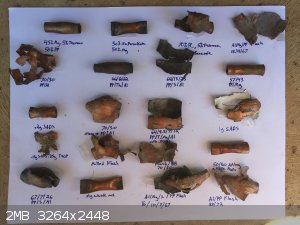
[Edited on 24-11-2016 by MineMan]
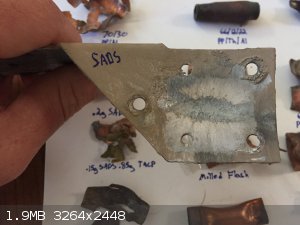 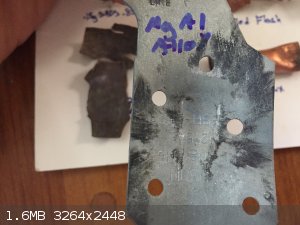
[Edited on 24-11-2016 by MineMan]
[Edited on 24-11-2016 by MineMan]
|
|
|
MineMan
National Hazard
   
Posts: 998
Registered: 29-3-2015
Member Is Offline
Mood: No Mood
|
|
Looks like I did test the AP and Mg... it did not break the tube, I think I did a 60/40 mixture...
Anyway. Here are more pics.
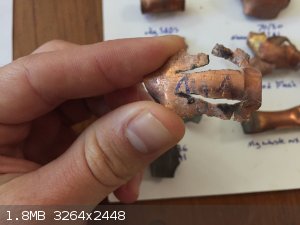 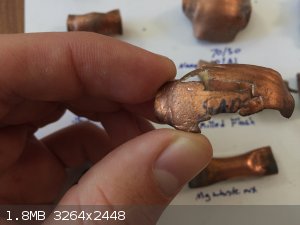
|
|
|
MineMan
National Hazard
   
Posts: 998
Registered: 29-3-2015
Member Is Offline
Mood: No Mood
|
|
Here is the U2U message I sent to Dornier. You will note that I said Mg/Al does not even break the tube, while the pictures show it did! That is
because Mg/Al did not break the tube, but when the alloy magnalium did, that is the test the pictures show. Anyways, I bought lithium aluminum
hydride, to expirrment with, and if any experienced members have suggestions that they think will work better than I will buy it, and try it, such as
zirconium, hafnium and ect???
I think powdered titanium would work well, but I cannot find flake titanium any smaller than 150mesh, and the material has been too hard for me to
mill or grind. I think hydrides would work well to because of the huge H2 output, but it has been impossible for me to find Zr hydride, Al hydride,
Mg Hydride, and Ti Hydride.
Anyways, here is my U2U message to Dornier.
Hello Dornier,
I have been experimenting a lot with different flash powder formulas trying to find the most brisant one, and I have hit a wall and am asking for your
guidance. I am measure the brisance by putting a gram of flash in a thick copper tube (3cm long, 7mm id, 8.5mm OD) and crimping both ends (and around
the fuse), with a 2mm fuse coming out one end. This is then put in a bucket of sand and lit. I am measuring the brisance by the how shredded the tube
is afterwards and how deep the indentations from the sand are in the post blast tube.
What I have found has surprised me. The majority of flash compositions will not break the tube, but rather just open the ends! Also, just because a
composition burns fast, or self confines in the open does not mean it performs better confined.
Btw, the Al powder is german dark and the Mg is 5 micron average and spherical.
I have tried several different ratios of the following flash powders, some from inspiration from your video!
Persulfate/Mg- self confines in the open but did not deform the Cu tube and just opened one crimped end.
KPerchlorate/Mg- self confines in the open, but did not deform the copper tube, just opened both ends.
SADS- For comparison broke tube into 3 main pieces, numerous sand dents on the pieces.
Kperchlorate/Mg/Al- breaks the tube open, no sand dents.
Kperchlorate/Mg/Al/S-breaks the tube, borderline shreds, some sand indents.
Kperchlorate/Al- shreds tube, some sand indents, post blast tube look similar to SADS, but without as many sand dents. Crushed sand found around tube.
Milled Kperchlorate/Al- used the steel plate method, spent 1 hour milling 1 gram in 50mg quantities. Burns faster in the open, but did not shred the
tube like non-milled. Milling this mix does not seem to help? I have tried milling the components seperatly and mixing them.
KPerchlorate/S/Al- shimzu's thunder worked best, shredded tube like 70/30 but the extra sensitivity does not make it worth it.
Kperchlorate/Thoruea/Al- usually just opens, some mixtures will break tube, less brisant than without thioruea.
Flash powder mixes with whistle mixes- just opens both ends of the tube.
Chlorate whistle mix with thioruea- breaks tube, no where near 70/30
KClO3/Al- breaks tube like perchlorate flash, maybe a little more brisant, but not worth the extra sensitivity. According to Klapotke this should be
much more powerful than Perchlorate flash, his balistic motor test showed this has 80% the power of Lead Azide.
Ammonium Perchlorate/Mg- Just opens tube.
Ammonium Perchlorate/Al- impossible to ignite.
[Edited on 24-11-2016 by MineMan]
[Edited on 24-11-2016 by MineMan]
|
|
|
PHILOU Zrealone
International Hazard
    
Posts: 2893
Registered: 20-5-2002
Location: Brussel
Member Is Offline
Mood: Bis-diazo-dinitro-hydroquinonic
|
|
@Mineman,
Now the entire world knows your finger prints 
Nice study of yours.
Maybe that some of the mixes are sub critical weight or diameter....would be nice to pursue the study with larger diameters and weights (but stil
friendly <5g) .
I don't get something into your first image... at the extreme right you have 1g SADS destroyed pipe and into the same line extreme left 2g SADS
undestroyed pipe --> WTF?
PH Z (PHILOU Zrealone)
"Physic is all what never works; Chemistry is all what stinks and explodes!"-"Life that deadly disease, sexually transmitted."(W.Allen)
|
|
|
nitro-genes
International Hazard
    
Posts: 1048
Registered: 5-4-2005
Member Is Offline
|
|
Isn't that a dot before the 2? 
Just an idea, regarding high order flashpowders. How well have formulas based on crackling microstars been characterized? Microstars (in my lmited
experience making them) show high brisancy and are at near TDM. They most likely burn before the rest of the mass makes DDT (sort of). I'm not sure
how well the contributing factors have been srted out, though an environmentally friendly material behaving reliably like that inside a detonator may
have great potential.
|
|
|
Bert
Super Administrator
        
Posts: 2821
Registered: 12-3-2004
Member Is Offline
Mood: " I think we are all going to die. I think that love is an illusion. We are flawed, my darling".
|
|
The micro star mixtures are size limited, in my experience. At a certain rather small Dia., they explode after a brief smoulder. Make them bigger and
only PART of the star explodes, scattering the rest of the material.
No one seems to have a definite answer as to what the heck the chemistry of this ignition mechanism really is, AFAIK.
And as far as environmentally friendly? Perhaps with the Bismuth trioxide recipe, the Lead version?!
As far as the disapointing Ammonium perchlorate:Mg 60:40 salute mixture, a gram at a time is not how I have seen it used. 100 grams compared side by
side with the standard 70:30 flash may impress you a bit more? As previously mentioned, the people who reportedly use a small flash powder device
initiated amonal charge to replace many pounds of standard 70:30 Potassium perchlorate:Aluminum flash are doing this in large bottom shots such as in
an 8" or larger cylinder shell, and the "small flash device" is the size of a 3" aerial cylinder salute... Which easily holds over 3 Oz. of flash.
I am quite certain that flash can be used to fire 90:10 ammonium nitrate:Aluminum powder. I am also pretty sure that the ammount required for a good
margin of certainty is a deal larger than the 1 gram devices used in the above tests.
Incidentally, do you have access to Antimony trisulfide?
[Edited on 25-11-2016 by Bert]
Rapopart’s Rules for critical commentary:
1. Attempt to re-express your target’s position so clearly, vividly and fairly that your target says: “Thanks, I wish I’d thought of putting it
that way.”
2. List any points of agreement (especially if they are not matters of general or widespread agreement).
3. Mention anything you have learned from your target.
4. Only then are you permitted to say so much as a word of rebuttal or criticism.
Anatol Rapoport was a Russian-born American mathematical psychologist (1911-2007).
|
|
|
MineMan
National Hazard
   
Posts: 998
Registered: 29-3-2015
Member Is Offline
Mood: No Mood
|
|
Yes, Bert. It is 1 gram just for testing, not for setting off ammonal. Philou, it was .2grams; also I am not interested in mixtures that cannot work
in less than 1 gram quantities.
No thoughts on the hydrides or the excotics like hafnium. Or Ti?
[Edited on 25-11-2016 by MineMan]
|
|
|
nitro-genes
International Hazard
    
Posts: 1048
Registered: 5-4-2005
Member Is Offline
|
|
Another composition I remember as being interesting was one called k1k, it consisted of 60% potassium picrate and 40% potassium perchlorate. In don't
recall the details, but with very strong reinforcement it was claimed to be able to initiate RDX in 100 mg quantities. This would be easily made and
have nearly unlimited shelf life, so maybe interesting to test also. 
Micro stars are size limited iabout 4 mm or so (IICR?) and most use quite toxic oxidizers indeed. Like you said, the very fact little is known about
the mechanisms involved is very interesting and a detailed look at all the factors involved may be of value. There are many experiments that would be
interesting to look at with these compositions, but that is for another thread maybe.
|
|
|
kratomiter
Hazard to Others
  
Posts: 106
Registered: 30-9-2012
Member Is Offline
Mood: No Mood
|
|
My knowledgement in flash powder is almost null, but recently I've been playing with strontium peroxide and magnalium and its power suprised me. I
have one silly question: the reaction SrO2 -> SrO + 1/2 O2 is exothermic? Can strontium peroxide based flash powder go high order?
BTW, Antimony trisulfide is now available on eBay.
|
|
|
Bert
Super Administrator
        
Posts: 2821
Registered: 12-3-2004
Member Is Offline
Mood: " I think we are all going to die. I think that love is an illusion. We are flawed, my darling".
|
|
Quote: Originally posted by MineMan  | Yes, Bert. It is 1 gram just for testing, not for setting off ammonal. Philou, it was .2grams; also I am not interested in mixtures that cannot work
in less than 1 gram quantities.
No thoughts on the hydrides or the excotics like hafnium. Or Ti?
[Edited on 25-11-2016 by MineMan] |
Where your quest is at?
1: Composition needs to be capable of initiating amonal, used in only 1 gram quantities, easily lit by a visco fuse or commonly available electric
match.
2: Composition must be substantially safer to handle than more commonly used primaries such as azides, acetylides or organic peroxides.
3: Composition ingredients must be fairly easy to obtain without overcoming regulatory issues by an unlicensed amateur, and possible to process "on
site" for nearly immediate use, ideally no more difficult than mixing up a Tannerite target... For the same reasons, a non commercial user avoiding
the need to comply BATF storage and licensing requirements, along with avoiding DOT category 1 explosive transportation requirements/insurance. Or at
least to provide a level of plausible deniability that such regulations HAD to have been violated in your creation of the explosion an authority is
asking you hard questions about...
You know the old joke, "Good, cheap, fast. Pick any two..."
---------------
OK. Going to exotics PROBABLY violates either parameter #2 (sensitivity or chemical instability/incompatability issues, I remember all too well how I
learned NOT to handle Zr powders dry), or #3 ( you just bought some unobtanium off of eBay! CHEAP!).
So you are left with the (mostly) common ingredients, and need to do some ENGINEERING.
Perhaps it is time to pick your best couple of chemical systems and start to look at processing schemes to achieve their best performance?
Figure out the best particle size/shape/packing geometries and loading density for the fastest spread of flame/quick transition to a detonation wave
in these mixtures.
You have noticed that the extremely fine 70:30 behaved counter intuitively? The only thing that you changed was particle size of the oxidizer...
Some have chosen particle sizes much as they are when making the best possible concrete agregate mixture. Then tumbled the ingredients with processing
aids such as Cab-O-Sil to promote a near perfect particle mixture and just sufficient interstitial space for the reaction front to propagate through
the mixture.
OxOxOxOxOxOxO
xOxOxOxOxOxOx
OxOxOxOxOxOxO
xOxOxOxOxOxOx
OxOxOxOxOxOxO
O is an oxidizer particle, x a very small particle of a metal fuel, with use of processing aids to ensure each particle of oxidizer becomes evenly,
THINLY coated with fuel, leaving virtually no "clumps" of additional fuel or oxidizer particles left less than optimally mixed. One could pre mix
appropriate sizes of oxidizer particles and a processing aid, then add fuel(s), briefly tumble the complete mix on site just beore use.
You might want to get a cheap microscope with some means of measuring size of particles? And learn about electrostatic effects on mixing of such very
fine particles.
Cab-O-Sil is a commonly used processing/mixing/anti cake additive, it is available with several different surface properties. Why would industrial
users need that?
[Edited on 25-11-2016 by Bert]
Rapopart’s Rules for critical commentary:
1. Attempt to re-express your target’s position so clearly, vividly and fairly that your target says: “Thanks, I wish I’d thought of putting it
that way.”
2. List any points of agreement (especially if they are not matters of general or widespread agreement).
3. Mention anything you have learned from your target.
4. Only then are you permitted to say so much as a word of rebuttal or criticism.
Anatol Rapoport was a Russian-born American mathematical psychologist (1911-2007).
|
|
|
MineMan
National Hazard
   
Posts: 998
Registered: 29-3-2015
Member Is Offline
Mood: No Mood
|
|
Potassium Picrate is already classified as an explosive, therefore I could not create a binary.
Bert, you are a mind reader, yes all three, however, I don't think it has to be 1 gram, it would be more than that. Even if something is exotic it
can be worth the price. Especially if we need only several grams! SADS is expensive because of the silver... I would be ok if the resulting
composition costs even $1 a gram.
Zr, I heard that it makes pyro comps extremely sensitive, especially static wise, funny thing though is that Zr hydride makes compounds anti static
according to patents.
Yes Bert, that is the problem with flash, as the particles get smaller it becomes more sensitive to static and friction. Antimony trisulfide might
help, but I don't think it would be worth the extra sensitivity.
Bert, as far as the second part of your post I am not clear on what you mean.... other than finding the best particle size or combination of sizes for
flame front propagation? The problem with Cab-o-sil is it would have to be added afterwards to make sure it does not coat the oxidizer where we would
want the fuel instead.
Another thought I have is that the the monroe effect seems to work with low explosives "The earliest mention of hollow charges occurred in 1792. Franz
Xaver von Baader (1765–1841) was a German mining engineer at that time; in a mining journal, he advocated a conical space at the forward end of a
blasting charge to increase the explosive's effect and thereby save powder.[3] The idea was adopted, for a time, in Norway and in the mines of the
Harz mountains of Germany, although the only available explosive at the time was gunpowder, which is not a high explosive and hence incapable of
producing the shock wave that the shaped-charge effect requires"
And https://patents.google.com/patent/US3759182A/en
|
|
|
PHILOU Zrealone
International Hazard
    
Posts: 2893
Registered: 20-5-2002
Location: Brussel
Member Is Offline
Mood: Bis-diazo-dinitro-hydroquinonic
|
|
Quote: Originally posted by MineMan  | Potassium Picrate is already classified as an explosive, therefore I could not create a binary.
Bert, you are a mind reader, yes all three, however, I don't think it has to be 1 gram, it would be more than that. Even if something is exotic it
can be worth the price. Especially if we need only several grams! SADS is expensive because of the silver... I would be ok if the resulting
composition costs even $1 a gram.
Zr, I heard that it makes pyro comps extremely sensitive, especially static wise, funny thing though is that Zr hydride makes compounds anti static
according to patents.
Yes Bert, that is the problem with flash, as the particles get smaller it becomes more sensitive to static and friction. Antimony trisulfide might
help, but I don't think it would be worth the extra sensitivity.
Bert, as far as the second part of your post I am not clear on what you mean.... other than finding the best particle size or combination of sizes for
flame front propagation? The problem with Cab-o-sil is it would have to be added afterwards to make sure it does not coat the oxidizer where we would
want the fuel instead.
Another thought I have is that the the monroe effect seems to work with low explosives "The earliest mention of hollow charges occurred in 1792. Franz
Xaver von Baader (1765–1841) was a German mining engineer at that time; in a mining journal, he advocated a conical space at the forward end of a
blasting charge to increase the explosive's effect and thereby save powder.[3] The idea was adopted, for a time, in Norway and in the mines of the
Harz mountains of Germany, although the only available explosive at the time was gunpowder, which is not a high explosive and hence incapable of
producing the shock wave that the shaped-charge effect requires"
And https://patents.google.com/patent/US3759182A/en
|
Maybe 3,5-dinitrobenzoate of Na/K and Na or K Chlorate or perchlorate. Since benzoate/chlorate is already whistle mix...with one or two nitro
extra's...it should perform better.
SADS/SANC (silver acetylide double salt/silver acetylide nitrato complex) is not that expensive...especially if you find a source of cheap silver
jewelry/coins.
If it is the price that stops you...spice up your flash with dispersed SADS dust...I have done it for a demo at University open day on coarse average
KClO3 black powder (kind of Bengal's fire burning)...and believe me even 1% SADS makes a strong difference.
No wonder that even low detonating mixes allow for kind of the same effect as higher detonating HE...the effect is logical and geometrical...as soon
as the propagation wave is faster into the solid explosive mix than into the air void (what is always the case with detonation)...it will de facto
generate a compressed bubble that will collapse forward and directional with a higher pressure, speed and temperature than the detonating mix would
acheive without the void.
Cumulative charge simulation.
Look carefully during the first second of the simulation...the detonation wave into the solid is 2 to 3 times faster than into the void.
[Edited on 26-11-2016 by PHILOU Zrealone]
PH Z (PHILOU Zrealone)
"Physic is all what never works; Chemistry is all what stinks and explodes!"-"Life that deadly disease, sexually transmitted."(W.Allen)
|
|
|
Laboratory of Liptakov
International Hazard
    
Posts: 1335
Registered: 2-9-2014
Location: Technion Haifa
Member Is Online
Mood: cool.gif
|
|
My opinion is , that only two samples are detonation. Described. Down is described
sample with deflagration - detonation properties with velocity from zero to 7500 m/s.
And output pressure 250 000 Bar at density 1,85 g/cm3 for copper hexamine perchlorate ( CHP).
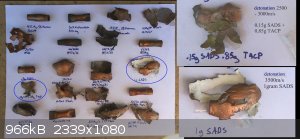
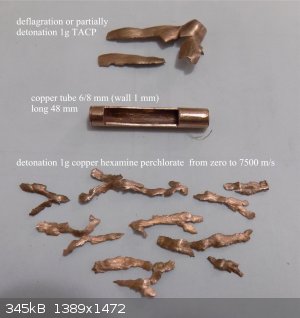
Next is very important, what describes Bert. Thus, that much better results will be with agglomerate with air gaps. Bigger grain. For cavity 6 - 7 mm
is it 1 - 2 mm agglomerate as basic size. And also this, what described Philou. Thus, that even very small amount SADS, for example 1 -5 % is
possible use in mixture for very good results with transition on detonation. With compatability materials, of course. Energetic material for
detonators will be thus cheaper. Dr.
Development of primarily - secondary substances CHP (2015) Lithex (2022) Brightelite (2023) Nitrocelite (2024)
|
|
|
MineMan
National Hazard
   
Posts: 998
Registered: 29-3-2015
Member Is Offline
Mood: No Mood
|
|
Can anyone remember or tell me vvideoupl sensitive ANNMAL recipe? All of his comments disappeared on youtube about a year ago.
He got to the point where he could kick it off with .1g of SADS. I am guessing it was over fueled and underwent DDT... such as 30%NM and 20%Al.
Anyone remember??
|
|
|
NeonPulse
Hazard to Others
  
Posts: 417
Registered: 29-6-2013
Location: The other end of the internet.
Member Is Offline
Mood: Isolated from Reality! For Real this time....
|
|
24%NM , 6%Al 70%NH4NO3. I'm pretty sure this was the ideal mixture. I would be highly skeptical that only 100mg SADS would fire this mixture though.
It is far too insensitive and in general a number 8 cap at the bare minimum will work but a small booster would be better.
If you do try a 100mg cap let us know if it successfully detonated your test charge.
|
|
|
MineMan
National Hazard
   
Posts: 998
Registered: 29-3-2015
Member Is Offline
Mood: No Mood
|
|
Hmm Neon, I would doubt that is his most sensitive.. It seems to OB balanced.
I have set off a similar mixture with .2g of SADS... but it was a pop and flash, not a detonation, but very close, .3g probably could have done it.
What about his watergels. He made them with peroxide and they were pretty cheap... any ideas on the formulation?
|
|
|
Laboratory of Liptakov
International Hazard
    
Posts: 1335
Registered: 2-9-2014
Location: Technion Haifa
Member Is Online
Mood: cool.gif
|
|
Watergels are generally problem on amateur field. I hear this : NH4NO3 ? % + NaNO3 10 - 15% + Al powder 20% + ethyleneglycol ? % + microballoons 2% +
guar gum 1% + water ?% to consistency porridge - gel. Minimum is diameter 40mm and 5g HE booster. Sensitivity is possible increase adding shotgun
powder 10%, but it is not cheap mixture. Even 20% Al is pretty expensive in this type. Was not tested, only hear that works. Dr.
Development of primarily - secondary substances CHP (2015) Lithex (2022) Brightelite (2023) Nitrocelite (2024)
|
|
|
agent_entropy
Hazard to Self
 
Posts: 91
Registered: 17-7-2006
Location: U.S.
Member Is Offline
Mood: No Mood
|
|
I've been seeing reference to microballoons throughout this thread and, despite my better efforts, I can't seem to find anything describing the
theory/practice of their use in terms of powders/EMs. Can anyone help with links to some literature? (I also tried the native search engine here)
|
|
|
Laboratory of Liptakov
International Hazard
    
Posts: 1335
Registered: 2-9-2014
Location: Technion Haifa
Member Is Online
Mood: cool.gif
|
|
Exist some magics the word. For exampe, if you into engine Google you writte: .....microballoons using explosive patents....
happend a miracle. During 0,66 seconds you have a full page of patents, where is detail describe and explained entire process and almost all about
microballoons. OK. Now you can pressed on first of them : https://www.google.ch/patents/US5880399
Especially, the word " PATENTS" is a base of successfull. Before "patents" is possible writte almost anything (science) and always you get pretty
good answer. Interesting.
For example: cast ammonium nitrate explosive patents. Results behind a 0,44s: https://www.google.com/patents/US2817581
and again is there described all important. Weird, but works it. Good a luck......and smile and waving!...... Kowalski.... .... ....
Dr.
Development of primarily - secondary substances CHP (2015) Lithex (2022) Brightelite (2023) Nitrocelite (2024)
|
|
|
PHILOU Zrealone
International Hazard
    
Posts: 2893
Registered: 20-5-2002
Location: Brussel
Member Is Offline
Mood: Bis-diazo-dinitro-hydroquinonic
|
|
Quote: Originally posted by agent_entropy  | | I've been seeing reference to microballoons throughout this thread and, despite my better efforts, I can't seem to find anything describing the
theory/practice of their use in terms of powders/EMs. Can anyone help with links to some literature? (I also tried the native search engine here)
|
Adiabatic shock compression of a gas bubble is the theory and practice behind this technology...it induces a local overheating (hot spot)...thus
helping propagation of the detonation shockwave (what is a very strong pressure impulsion).
You of course know that compressing a gas reduces the freedom of move of the molecules and as such if no exchange of energy is allowed to the external
world (because fast and out of equilibrium --> adiabatic)...the vibrational level of the molecules will increase (and that is related to
Temperature)...shortly a compressed gas heats up...and reversely a decompressed gas cools down.
If the pressure difference between the initial pressure and the final one is 20 for example...you already reach approx 1300°C into the bubble...but
into a detonation wave the pressure gap is much higher than 20...so accordingly the temperature will be much higher too.
This is used only for very unsensitive explosives and some that can be dead pressed...the only drawback of the sensitivity increase is the reduction
of the power because of course introducing air gaps (microballoons) reduces the density and the amount of explosive material per volumic unit...and
density is very important for detonic parameters like velocity of detonation, brisance, sand crushing, ...
PH Z (PHILOU Zrealone)
"Physic is all what never works; Chemistry is all what stinks and explodes!"-"Life that deadly disease, sexually transmitted."(W.Allen)
|
|
|
agent_entropy
Hazard to Self
 
Posts: 91
Registered: 17-7-2006
Location: U.S.
Member Is Offline
Mood: No Mood
|
|
Thanks, PH Z and Dr Liptakov, I must have been using all the wrong keywords
[Edited on 4-7-2017 by agent_entropy]
|
|
|
| Pages:
1
..
3
4
5 |